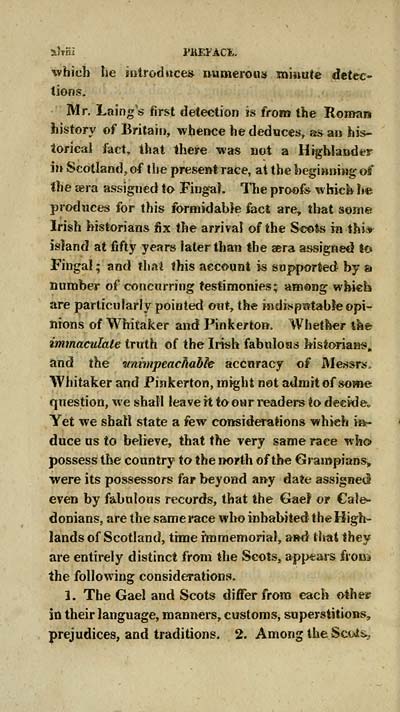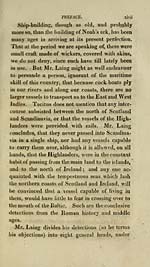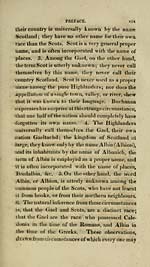J. F. Campbell Collection > Original collection of the poems of Ossian, Orrann, Ulin, and other bards, who flourished in the same age
(58)
Download files
Complete book:
Individual page:
Thumbnail gallery: Grid view | List view

-s-hiil PKEFACL.
which he introduces mimerous m'mute detec-
tions.
Mr. Laing's first detection is from the Roman
history of Britain, whence he deduces, as an his-
torical fact, that there was not a Hrghlauder
m Scotland, of tiie present race, at the heginnijig of
the s&ra assigned to FingaL The proofs which !i©
produces for this formidable fact are, that some
Irish historians fix the arrival of the Sco^s in thi*
island at fifty years later than the sera assigned t(s
Fingal ; and thai this account is supported by &
number of concurring testimonies; among whieb
are particularly pointed out, the isj disputable opi-
nions of Whitaker and Pinkerton, Whether th&
immaculate truth of the Irish fabiilosis ltistoriani*j^
and the vnimpeachahh accnracy of Messrs,
Whitaker and Pinkerton, might not admit of some
question, we shall ieave it to our readers to decide.
Yet we shall state a few considerations which in-
duce us to believe, that the very same race who
possess the country to the north of the Grampians,
were its possessors far beyond any date assigned
even by fabulous records, that the Gael or Cale-
donians, are the same race who inhabited the High-
lands of Scotland, thne maraemorial, a»d that Ihey
are entirely distinct from the Scots, appeai-s fronn
the following considerations,
2. The Gael and Scots differ from each otheie
in their language, manners, customs, superstitions,
prejudices, and traditions. 2. Among the Scots.^
which he introduces mimerous m'mute detec-
tions.
Mr. Laing's first detection is from the Roman
history of Britain, whence he deduces, as an his-
torical fact, that there was not a Hrghlauder
m Scotland, of tiie present race, at the heginnijig of
the s&ra assigned to FingaL The proofs which !i©
produces for this formidable fact are, that some
Irish historians fix the arrival of the Sco^s in thi*
island at fifty years later than the sera assigned t(s
Fingal ; and thai this account is supported by &
number of concurring testimonies; among whieb
are particularly pointed out, the isj disputable opi-
nions of Whitaker and Pinkerton, Whether th&
immaculate truth of the Irish fabiilosis ltistoriani*j^
and the vnimpeachahh accnracy of Messrs,
Whitaker and Pinkerton, might not admit of some
question, we shall ieave it to our readers to decide.
Yet we shall state a few considerations which in-
duce us to believe, that the very same race who
possess the country to the north of the Grampians,
were its possessors far beyond any date assigned
even by fabulous records, that the Gael or Cale-
donians, are the same race who inhabited the High-
lands of Scotland, thne maraemorial, a»d that Ihey
are entirely distinct from the Scots, appeai-s fronn
the following considerations,
2. The Gael and Scots differ from each otheie
in their language, manners, customs, superstitions,
prejudices, and traditions. 2. Among the Scots.^
Set display mode to: Large image | Transcription
Images and transcriptions on this page, including medium image downloads, may be used under the Creative Commons Attribution 4.0 International Licence unless otherwise stated. ![]()
| Early Gaelic Book Collections > J. F. Campbell Collection > Original collection of the poems of Ossian, Orrann, Ulin, and other bards, who flourished in the same age > (58) |
|---|
| Permanent URL | https://digital.nls.uk/81002331 |
|---|
| Description | Volumes from a collection of 610 books rich in Highland folklore, Ossianic literature and other Celtic subjects. Many of the books annotated by John Francis Campbell of Islay, who assembled the collection. |
|---|
| Description | Selected items from five 'Special and Named Printed Collections'. Includes books in Gaelic and other Celtic languages, works about the Gaels, their languages, literature, culture and history. |
|---|

